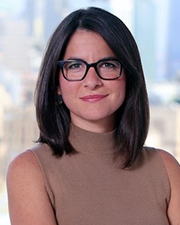2021 Women in Building Services: Ámbar Margarida, Spacesmith LLP
Name: Ámbar Margarida, CID, IIDA, Assoc. AIA, LEED GA, WELL AP
Title: Principal
Company Name: Spacesmith LLP
Real estate associations or organizations that you are currently a member of: The Latino American Commercial Real Estate Association (LACREA), CoreNet Global, Ambassadors Board of Young New Yorkers
What did you want to be when you grew up?
I’ve wanted to be an interior designer since I was 12 years old. I’d finally moved into my own room and got to redesign it. I was inspired. I liked how design combines function and art. There’s also service involved, empathy and creativity. You need to understand who you’re designing for and have empathy and an understanding of where they’re coming from and the problems they’re proposing that you solve.
Who was/is your mentor and how did s/he influence/help you in your career?
I admire many people, but a major influence has been Jane Smith, FAIA, Spacesmith partner. We met at the School of Visual Arts when I was a second-year student, and she was chair of the Interior Design Department. Later, I interned, then began working at Spacesmith. At every stage of my design career and teaching work, Jane has been a great mentor. Elisabeth Post-Marner, AIA, LEED AP, an award-winning architect, is a colleague and mentor, also. Her home was built with passive-design principles, and I admire her way of mentoring as well as her design sensibility and headquarters spaces that she is renowned for.
What led you to your current profession?
After graduating from the School of Visual Arts with an ID degree during the 2009 recession, I started with the firm by helping with marketing and business development. I wrote proposals and learned about business development, built teams of engineers, put together schedules and budgets. I went into design work and project management and now I’m a principal. The difference in being a young designer and principal is the change in responsibilities. As a principal, you’re client-facing while at the same time being a mentor to junior staff members.
If you ask me what my one passion is, it would be learning. I aspire to keep growing and doing good; to build lasting work and relationships, not necessarily titles.
In the past year, what project, transaction or accomplishment are you most proud of?
We recently completed the headquarters of the New York Legal Assistance Group (NYLAG) and used trauma-informed design principles. NYLAG provides free legal representation to people who can’t afford it and are often going through trauma. Clinical research proves our environment affects our physical and psychological wellbeing. For instance, a victim of domestic violence may be uncomfortable with their back against the door. Even simple furniture placement–your back against a wall–can make you feel safer. Abstract art can trigger negative emotions, but nature and natural patterns promote calm. I’m also proud of our work with SCO Family of Services in New York, a non-profit that provides human services and support to New York families.
What trends will dominate your industry in the coming months?
I expect a continued emphasis on occupant wellness, like air quality, light quality, and integrated technology. In New York City, industry professionals are working to comply with Local Law 97 that addresses energy efficiency for buildings larger than 25,000 s/f.
I also expect more projects to apply for WELL building standards or the more stringent Living Building Challenge’s Red List that names 200 chemicals that shouldn’t be used in building products. I’m interested in environmental psychology, trauma-informed design, biophilia, how lighting affects our mood and behavior, and asking questions like, “How does a space make you feel safe or unsafe?”
How do you contribute to your community or profession?
I teach evidence-based design and critical thinking to Interior Design undergraduates at my alma mater, the School of Visual Arts. I just finished my second year teaching there and love it. I’m also on the Ambassadors Board of Young New Yorkers, an organization that provides arts diversion programs rooted in restorative justice to court involved youth. We just had a terrific youth led forum with the Manhattan DA Candidates. I also helped establish The Latino American Commercial Real Estate Association (LACREA) and still help organize events for LACREA.
What books or social media influencers would you recommend to other women?
Two books come to mind, “Joyful: The Surprising Power of Ordinary Things to Create Extraordinary Happiness,” by Ingrid Fetell Lee, and “The Shaping of Us: How Everyday Spaces Structure our Lives, Behaviour, and Well-Being,” by Lily Bernheimer.
“Joyful,” I’ve had for a while. I love the way she looks at what in our environment brings us joy and how to create more of it. As a designer, if I can understand those keys and create those experiences for people, then I’ve done my job – created a little more joy.
In the “Shaping of Us,” Bernheimer talks about things like seating geometry and references sociologist and psychologist studies. Sitting opposite to someone can be confrontational; sitting at 90 dgrees is more conversational. It all talks space, environments, sociology and psychology.
Over half of Long Island towns vote to exceed the tax cap - Here’s how owners can respond - by Brad and Sean Cronin


Properly serving a lien law Section 59 Demand - by Bret McCabe

The strategy of co-op busting in commercial real estate - by Robert Khodadadian

Oldies but goodies: The value of long-term ownership in rent-stabilized assets - by Shallini Mehra







.png)

.gif)
.jpg)
.gif)